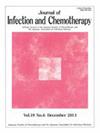Molecular epidemiology and clinical characteristics of Staphylococcus aureus bacteremia in Japanese adults
IF 1.9
4区 医学
Q3 INFECTIOUS DISEASES
引用次数: 0
Abstract
Introduction
Staphylococcus aureus bacteremia (SAB), especially when caused by methicillin-resistant S. aureus (MRSA), is of considerable clinical importance. In recent years, the proportion of MRSA among S. aureus has decreased, and a relative increase in the proportion of methicillin-susceptible S. aureus (MSSA) has been observed. It is therefore necessary to consider both MRSA and MSSA when assessing the microbiological and clinical significance of SAB.
Materials and methods
We included SAB cases from the Nara Medical University Hospital between January 2015 and February 2017. We performed drug susceptibility testing, toxicity gene analysis, multilocus sequence typing (MLST), and polymerase chain reaction-based open reading frame typing (POT) of stored strains to integrate clinical and bacteriological characteristics.
Results
There were 90 cases during the experimental period (42 MRSA and 48 MSSA), with 30-day mortality rates of 19 % for MRSA and 10.4 % for MSSA. Deaths were more frequently complicated by septic shock and disseminated intravascular coagulation. MLST studies showed that ST8, ST764, ST1, and ST15 were prevalent in the MRSA group, whereas ST5, ST188, and ST12 were prevalent in MSSA. Infective endocarditis cases had a long time from onset to the initiation of effective antimicrobials and were all MSSA. MLST and POT results correlated well, and POT appeared to have better discriminatory power.
Conclusions
The severity and mortality of SAB, along with the microbiological characteristics of causative isolates, vary by location and time. Continued studies integrating clinical and microbiological investigations are thus needed.
日本成人金黄色葡萄球菌菌血症的分子流行病学和临床特征。
导言:金黄色葡萄球菌菌血症(SAB),尤其是由耐甲氧西林金黄色葡萄球菌(MRSA)引起的 SAB,具有相当重要的临床意义。近年来,金黄色葡萄球菌中 MRSA 的比例有所下降,而甲氧西林耐药金黄色葡萄球菌(MSSA)的比例则相对上升。因此,在评估 SAB 的微生物学和临床意义时,有必要同时考虑 MRSA 和 MSSA:我们纳入了奈良医科大学医院 2015 年 1 月至 2017 年 2 月间的 SAB 病例。我们对储存的菌株进行了药敏试验、毒性基因分析、多焦点序列分型(MLST)和基于聚合酶链式反应的开放读码框分型(POT),以整合临床和细菌学特征:实验期间共有 90 例病例(42 例 MRSA 和 48 例 MSSA),30 天内 MRSA 死亡率为 19%,MSSA 死亡率为 10.4%。死亡病例多并发脓毒性休克和弥散性血管内凝血。MLST 研究显示,MRSA 组中流行 ST8、ST764、ST1 和 ST15,而 MSSA 组中流行 ST5、ST188 和 ST12。感染性心内膜炎病例从发病到开始使用有效抗菌药物的时间较长,且均为 MSSA。MLST和POT结果相关性良好,POT似乎具有更好的鉴别力:结论:SAB 的严重程度和死亡率以及致病分离菌的微生物学特征因地点和时间而异。因此,有必要继续开展综合临床和微生物学调查的研究。
本文章由计算机程序翻译,如有差异,请以英文原文为准。
求助全文
约1分钟内获得全文
求助全文
来源期刊

Journal of Infection and Chemotherapy
INFECTIOUS DISEASES-PHARMACOLOGY & PHARMACY
CiteScore
4.10
自引率
4.50%
发文量
303
审稿时长
47 days
期刊介绍:
The Journal of Infection and Chemotherapy (JIC) — official journal of the Japanese Society of Chemotherapy and The Japanese Association for Infectious Diseases — welcomes original papers, laboratory or clinical, as well as case reports, notes, committee reports, surveillance and guidelines from all parts of the world on all aspects of chemotherapy, covering the pathogenesis, diagnosis, treatment, and control of infection, including treatment with anticancer drugs. Experimental studies on animal models and pharmacokinetics, and reports on epidemiology and clinical trials are particularly welcome.
 求助内容:
求助内容: 应助结果提醒方式:
应助结果提醒方式:


